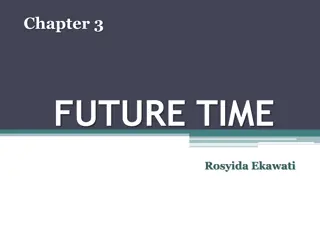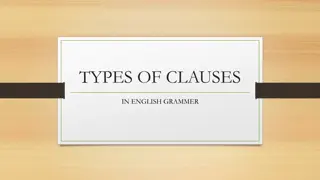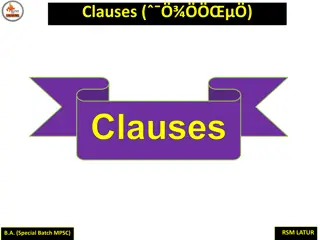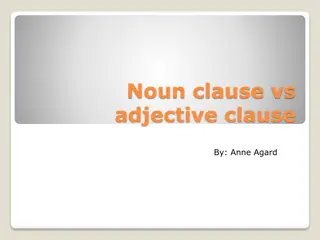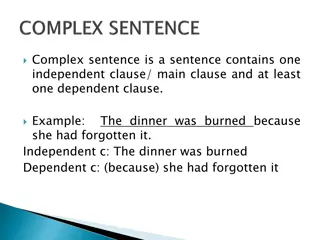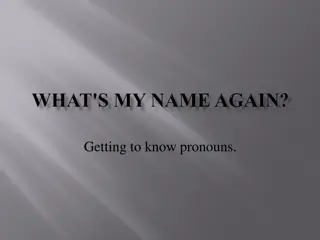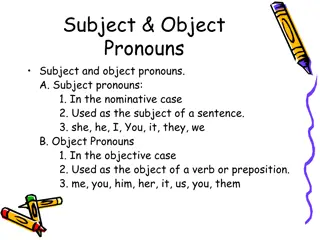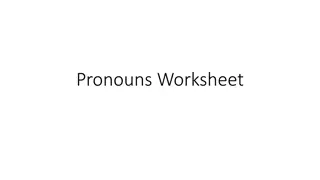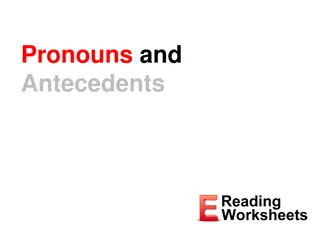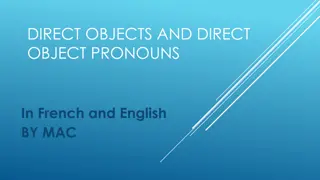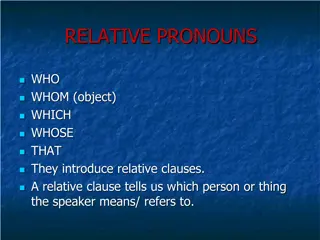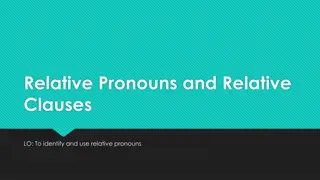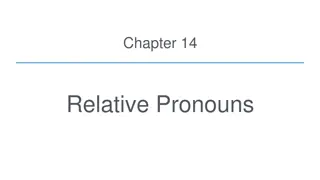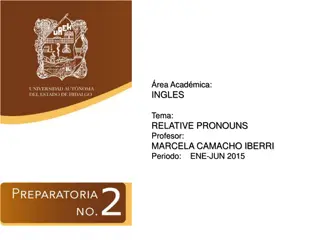Understanding Relative Clauses and Pronouns
Utilize relative clauses to provide additional information to a noun, using relative pronouns such as who, which, where, when, and whose. Learn how to construct complex sentences with at least two clauses, ensuring the subordinate clause complements the main clause. Explore examples and practical steps to enhance your writing with relative clauses.
Download Presentation

Please find below an Image/Link to download the presentation.
The content on the website is provided AS IS for your information and personal use only. It may not be sold, licensed, or shared on other websites without obtaining consent from the author. Download presentation by click this link. If you encounter any issues during the download, it is possible that the publisher has removed the file from their server.
E N D
Presentation Transcript
Aim to use relative clauses to add information to a noun. Success Criteria I know that a complex sentence has at least two clauses. I use the relative pronouns who, which, where, when and whose to begin a subordinate clause. I know that what is not a relative pronoun. I know that the relative pronoun comes after the main noun.
Lets start with a simple sentence. Matthew was playing the guitar. Not very interesting, is it? Why don t we add some extra information? Matthew was playing the guitar. He was in his bedroom. Ok, but still rather simple. How could we improve this?
Lets make it a complex sentence. Matthew was playing the guitar. He was in his bedroom. The second sentence adds a bit of non-vital information to the first one, so we can drop it in as a relative clause, like this Matthew, who was in his bedroom, was playing the guitar.
Weve dropped in a relative clause! Matthew, who was in his bedroom, was playing the guitar. subordinate clause main clause The main clause could be a sentence by itself and still make sense: Matthew was playing the guitar. However, the second sentence is now a subordinate clause, which doesn t make any sense by itself: Who was in his bedroom. The subordinate clause has to be stapled into the sentence with commas.
So its all relative, then? We ve replaced the pronoun in the second sentence with a relative pronoun. Can you spot it? Matthew was playing the guitar. He was in his bedroom. Matthew, who was in his bedroom, was playing the guitar. Whois the relative pronoun we use to replace people nouns/pronouns.
Other Relative Pronouns Which is the relative pronoun we use to replace objects nouns/pronouns. Apples grow on trees. They are very healthy. Apples, which are very healthy, grow on trees.
Other Relative Pronouns Whose is the relative pronoun we use to replace possessive pronouns. Victoria became Queen in 1837. Before Elizabeth II, her reign was the longest in British history. My dog is called Frizz. His fur is very curly. My dog, whose fur is very curly, is called Frizz. Victoria, whose reign was the longest in British history before Elizabeth II, became Queen in 1837.
Other Relative Pronouns Where is the relative pronoun we use to replace place nouns/pronouns. Mallorca is a Spanish island. We go there on holiday. Mallorca, where we go on holiday, is a Spanish island. The relative pronoun always goes straight after the main noun, so sometimes we have to re-order the clause slightly.
Other Relative Pronouns When is the relative pronoun we use to replace time noun phrases/pronouns. In 2008, I was two years old. My brother was born in 2008. In 2008, when my brother was born, I was two years old. The relative pronoun 'that' is used for relative clauses where the added information is vital to the meaning of a sentence. When using 'that', we tend not to use commas around the relative clause. For example: The old house that is next to our school is up for sale.
Instead of, not as well as Relative pronouns are used in relative clauses. Can you spot what s wrong with these new sentences? My mum is a doctor. Her name is Safira. My mum, whose her name is Safira, is a doctor. The writer has left the pronoun in the new subordinate clause, as well as adding a relative pronoun.
Punctuation Relative clauses containing non-vital information have to be separated from the main clause. Typically, we use commas to mark the relative clauses, although dashes or brackets can also be used. George was passed by a fire engine, which had its blue lights on. Hospitals (where doctors and nurses work) are very busy places. Grandma whoseeyes are sensitive has to wear dark glasses.
Plenary What have we learned? We can combine two simple sentences into a complex sentence using a relative pronoun. Relative pronouns look like question words, but they re actually replacing a noun. One of the sentences becomes a subordinate clause which we place after the noun.



